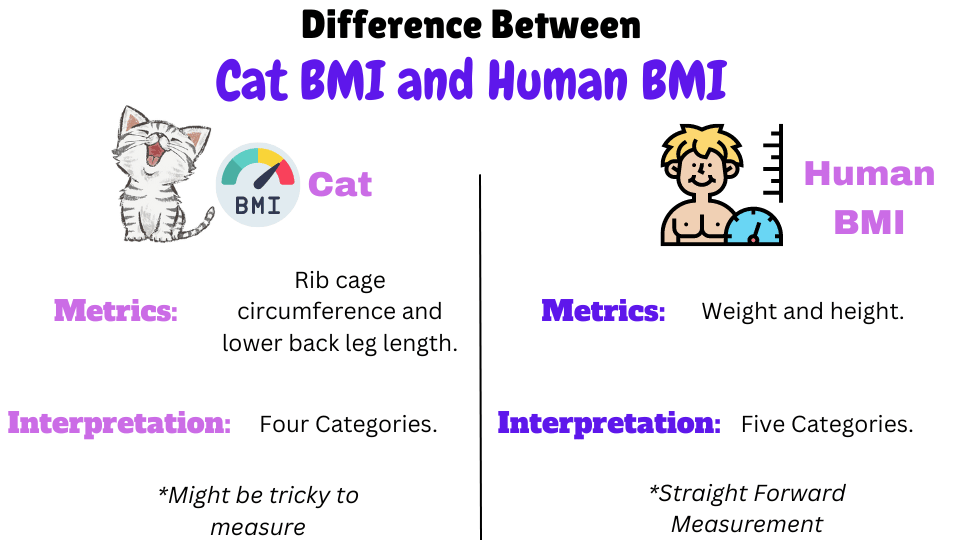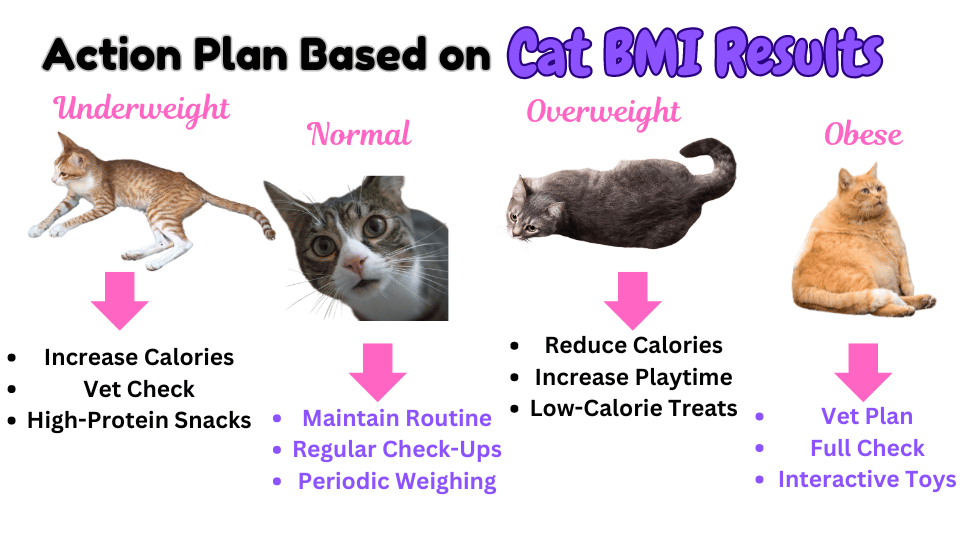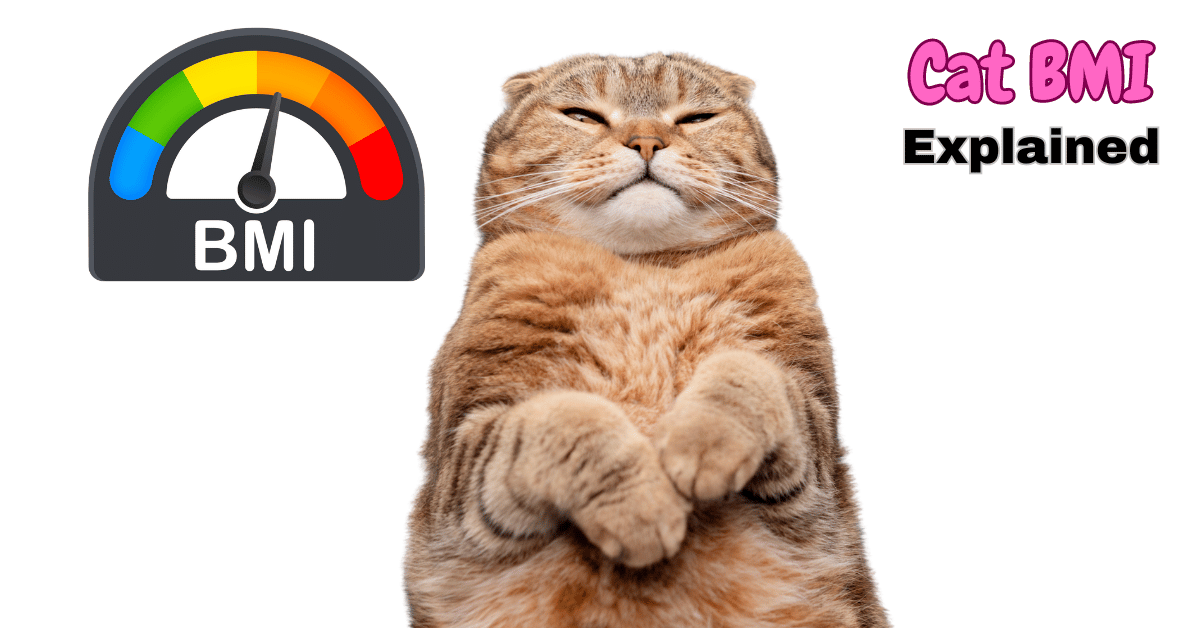Introduction: What is Cat BMI?
Cat BMI, or feline Body Mass Index (fBMI), is a simple yet effective metric that helps you determine if your kitty is within a healthy weight range. Much like the human BMI, Cat BMI provides an index to gauge your cat’s body condition. With their naturally fluffy coats, it can be challenging to notice when your feline friend might be carrying a bit too much weight.
The main difference is that while human BMI is calculated using weight and height, Cat BMI uses the rib cage circumference and the length of the lower back leg from knee to ankle (LIM).
The Feline Body Mass Index (FBMI) has become an invaluable tool for veterinarians and researchers. It allows for quick and reliable assessments of a cat’s body condition, helping to identify those at risk of obesity-related health issues.

Why is Cat BMI Important?
Knowing your cat’s BMI is crucial for several reasons:
- Prevent Health Issues: Monitoring BMI helps prevent obesity-related problems like diabetes, arthritis, and heart disease.
- Track Health Changes: Regularly checking BMI can alert you to sudden weight changes that might indicate health issues.
- Ensure Longevity: Maintaining a healthy BMI contributes to a longer, happier life for your cat.
- Comprehensive Health Monitoring: Simply weighing your pet is not enough. A healthy cat weight depends on many factors such as breed, age, and sex.
How is Cat BMI Calculated?
Calculating your cat’s BMI is a breeze with just two key measurements:
- Measure Your Cat’s Rib Cage: Find the 9th rib level near the front legs and wrap a measuring tape around to determine the circumference.
- Measure the Length of Your Cat’s Lower Back Leg: Measure from the knee to the ankle.
Once you have these measurements, input them into the cat BMI calculator. The formula for calculating the feline BMI (FBMI) is:

Where:
- Rib Cage is the circumference measurement.
- Leg is the length from knee to ankle.
Interpreting Cat BMI Results
Just like humans have their BMI ranges, cats have theirs too. But since our feline friends have a more streamlined system, there are four categories instead of five.
Here’s the FBMI (Feline Body Mass Index) chart to help you understand what your cat’s number means:
| FBMI | Interpretation |
|---|---|
| < 15 | Underweight |
| 15 – 29.9 | Normal weight |
| 30 – 42 | Overweight |
| > 42 | Obese |
Accuracy of Cat BMI
The Feline Body Mass Index (FBMI) is impressively accurate, boasting an 85% correlation with advanced dual energy X-ray absorptiometry (DEXA) scans.
This high level of accuracy means that calculating the cat BMI (FBMI) is a reliable predictor of your cat’s body fat, providing results that closely align with those obtained from more sophisticated and expensive methods like DEXA.
However, while Cat BMI is a useful tool, it’s not without limitations:
- Muscle Mass: BMI doesn’t differentiate between fat and muscle mass, potentially leading to inaccurate assessments for muscular cats.
- Age: Age-related changes in body composition are not considered, which can affect the accuracy of the BMI results.
- Measurement Precision: Precise measurements of the rib cage circumference and the length of the lower back leg are crucial. Even small errors in these measurements can significantly impact the BMI result.
- Measurement Difficulty: Accurately measuring a cat’s rib cage and leg can be challenging, which can further affect the reliability of the BMI calculation.
Other Ways to Measure a Healthy Weight in Cats
In addition to BMI, consider these methods for a comprehensive assessment:
- Body Condition Score (BCS): A visual and tactile assessment of your cat’s body fat.
- Regular Vet Check-Ups: Vets can provide professional evaluations and tailored advice.
- Weighing and Comparing Averages: Regularly weigh your cat and compare their weight to breed-specific averages to monitor and maintain an ideal weight.
How to Use Cat BMI Information
Once you know your cat’s BMI, here’s how you can use this information:

- Adjust Diet: If your cat is underweight or overweight, consider changing their diet. High-quality cat food tailored to their needs can make a big difference.
- Increase Exercise: Play more with your cat. Toys, cat trees, and exercise wheels can help keep them active.
- Consult a Vet: If your cat’s BMI is too high or low, it’s best to seek professional advice to rule out underlying health issues.
Common Questions About Cat BMI
How often should I check my cat’s BMI?
It’s a good idea to check your cat’s BMI every few months or during regular vet visits.
Can I use a regular scale to weigh my cat?
Yes, but for accuracy, a pet scale is recommended. If using a regular scale, weigh yourself first, then weigh yourself holding the cat, and subtract your weight from the total.
My cat is a bit chubby but seems healthy. Should I be worried?
A little extra weight might not be immediate cause for concern, but it’s essential to monitor and ensure it doesn’t lead to obesity-related health issues.
Meet Sean, a fintech whiz with a penchant for pet purrs and blockchain buzz. After a decade of fintech feats, Sean’s tech talents leaped from ledger lines to litter lines, driven by a passion for pets and a vision for a more connected pet care community. With three critter companions as co-pilots, Sean launched this blog to share a treasury of pet-friendly tech tips and tales.


